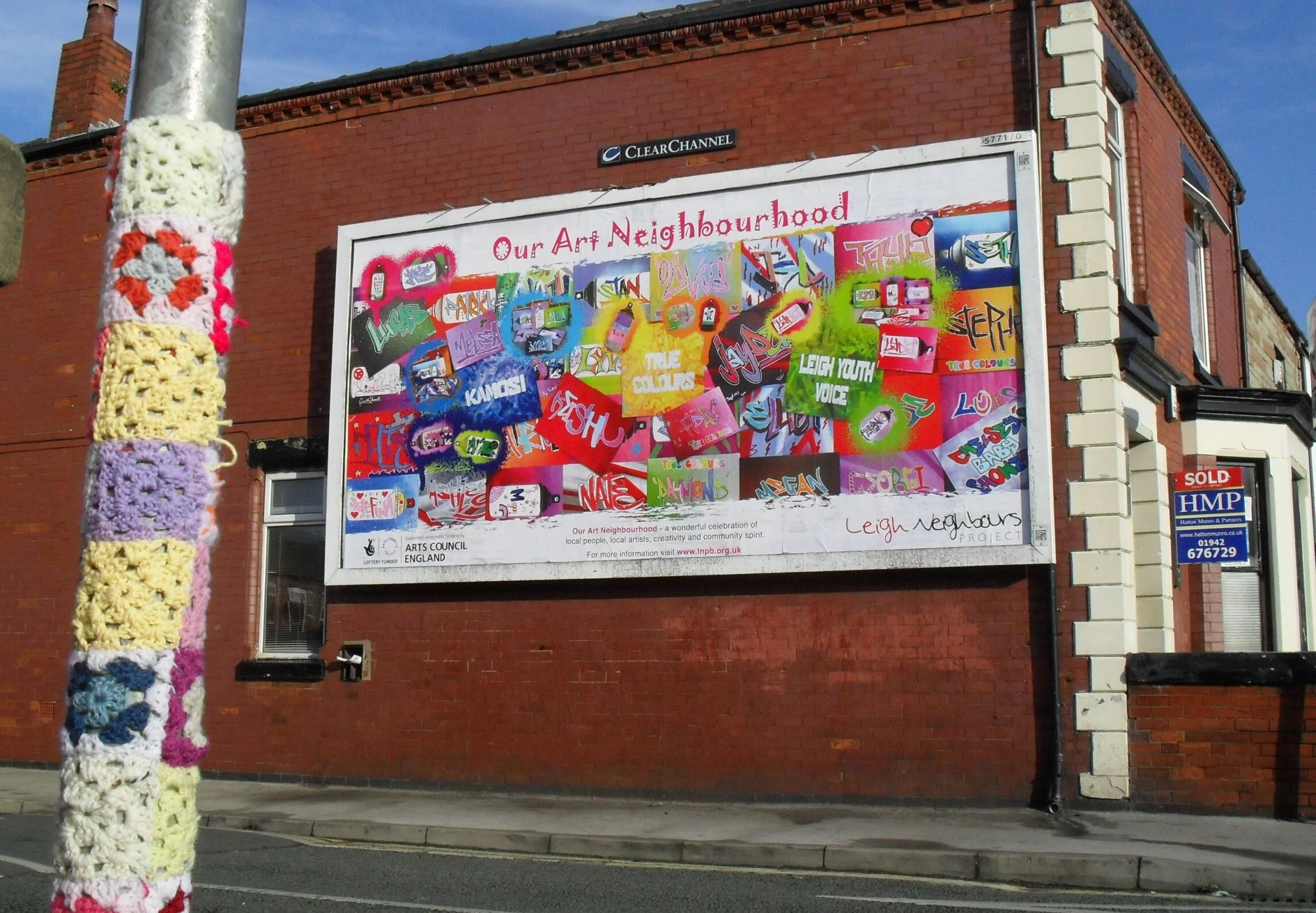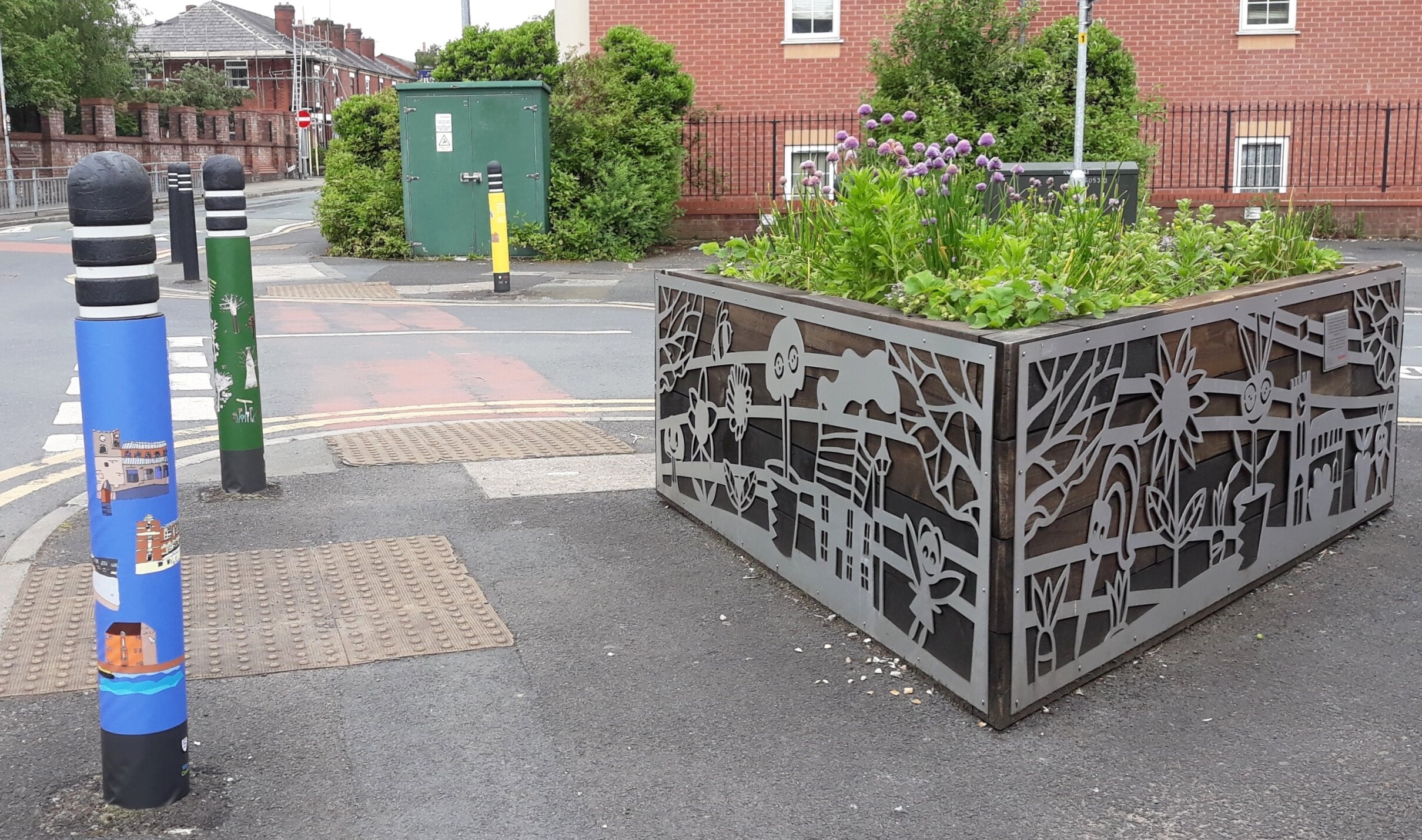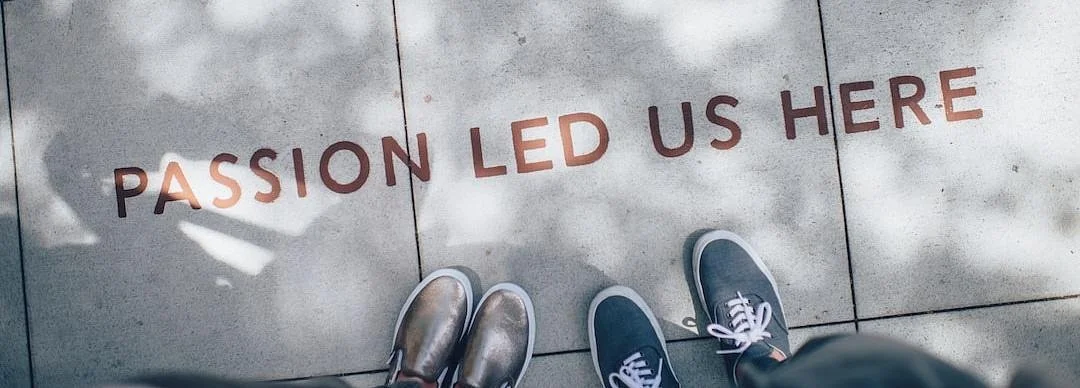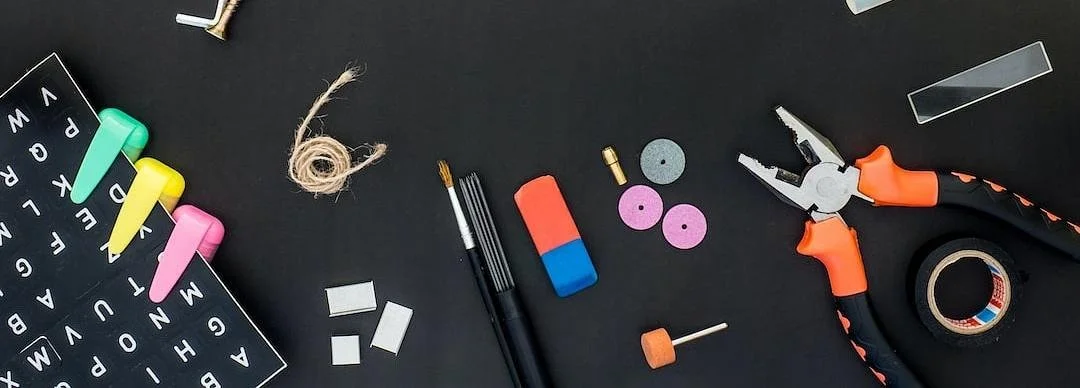The Presence of Past Voices
By
Martyn Lucas + Susannah Silver
Image description: black and white photograph, interior. A close up of a carpet laid out with analogue recording devices and materials, including a walkman, small microphone and empty cassette tape case. On the left side of the photograph, a pair of hands point towards one of the devices.
Published in September 2021 as part of the extended digital edition of Social Works? Open journal…
A conversation between Martyn Lucas and Susannah Silver in Spring 2021
Susannah Silver: Martyn, 25 years ago, I invited you to be a research subject in an artist-led public art project called Taming Goliath set in Aberdeen. This project provided the data for my doctoral thesis. [1] Its objective was to record how artists created contexts for their work outside the gallery and the experiences they had in bringing their projects to fruition. I wanted to make the process more explicit for everyone to understand. I invited you because you were working with groups and individuals in what was then called ‘community art’. When you worked on Taming Goliath, the theme of ‘dialogue’ influenced your approach and the project you set up: an art exchange between Aberdeen’s Children’s Hospital and the children’s wards at the Royal Free Hospital in London. Dialogue as a metaphor for engagement was very potent for you then—it runs through the transcripts of my Ph.D. Is it still as potent for you now in your socially-engaged practice? What has changed, what remains the same?
Cover of publication from Hospitals Talking Art 1997. Image description: colour photograph. A close-up of an envelope which has been well used, with several handwritten addresses visible. On the right hand side a note says ‘fragile’ underlined twice. Some overlaid text reads: ‘Hospitals Talking Art: recording the visual dialogue’.
Martyn Lucas: Thinking about it now, I guess there are four kinds of dialogue which come to mind — the dialogue I might have as an artist with people (who might be participants, stakeholders or decision makers); the dialogue which participants have among themselves, including the times when I am ‘not in the room’; the internal dialogue by which I make assessments and decisions; and the dialogue any artistic outcome of a project might have with an audience. These are all real conversations rather than metaphorical (apart maybe from the one in my head), so the notion of a dialogic practice which reveals, or shares experience is still relevant, as are the concepts of artistic enquiry through ‘knowing/unknowing’ and ‘finding a gap’. Now I see more clearly how complex these many dialogues are. Over time I may have come to understand my ethical values better and I still get anxious about negotiating with institutions ‘with authority’, such as the local council’s highways department.
SS: You have been working on a long-term project Our Art Neighbourhood in Leigh, Greater Manchester since 2014. Tell me about how you work with the residents. Is the idea of dialogue still a big influence or are there other metaphors now?
ML: For me the project started when I was invited to consider how participatory art might contribute to a community development plan within a specific area of the town. After piloting some temporary projects under the title Our Art Neighbourhood, local residents wanted more permanent art within the area. To generate ideas for artworks, and the forms they could take, I first walked the neighbourhood streets to intuitively ‘find the gap’, assessing which neglected physical spaces could become sites. I then went on a walk with some key stakeholders, residents, and board members of the project. Together we shared stories of the sites, with my collaborators suggesting other streets and places. Through these conversations a wide-ranging collection of anecdotes, personal and social histories emerged.


Alongside other visual artists, I then worked with residents and local school children to develop artworks which share the character and history of the area: through a planter sculpture (inspired by the ‘Incredible Edible’ concept of food growing and sharing where people are able to pick their own herbs, veg and fruit from street-side mini allotments), bollard art, and most recently a ‘Wall of Fame’. Our Art Neighbourhood can be seen as ‘outcome driven’ because the desire is to see physical art works which improve the look of local streets. The result may have a decorative function, yet beyond that is the aspiration to convey a sense of ‘we do care’—contributing to a developing sense of community spirit. Evolving from those first exploratory walks, these works emerge from a long, sometimes slow process of community engagement. Conversations take place with residents which inform the stages of development. We are making relatively low-cost artefacts, and while the budget is certainly not limitless, there is a sense of open-endedness which can accommodate the sharing, refining and sometimes rejection of ideas—ideas for artworks which emerge from a wide variety of sources and which come to fruition in a timely way. As with the book I made with Leslie Herbert all those years ago, there is the dialogue or exchange taking place where the relationship(s) feed the artwork and the artwork feeds the relationship(s). [2]
Page from ‘Dialogue’, 1995, an artists’ book with Leslie Herbert. Image description: black and white photograph. Close up of an open book, which has white pages and is spiral bound in black. The left side page is blank. The right page shows a hand drawing of a figure. The text reads ‘don’t muck about’.
25 years ago, Taming Goliath seemed like another good opportunity to further my experience and earn a wage for a few months. What your project generated was quite different to how I imagined. Not so much the outcome, where Hospitals Talking Art was one of the three artist-led projects with a public presentation (Public Address, Aberdeen, 1996), but in the process: especially the documentation of the decision making along the way. [3] The in-depth recording of process, in diaries and taped interviews, as well as innumerable informal conversations, not only probed my rationale but also encouraged me to develop that critical eye or inner voice.
I remember we attended events where we met people like Suzanne Lacy. It was the first time I had heard about artists working in this way on projects which went beyond my own clichéd notions of ‘community art’. There just weren’t the publications around at that time to read, were there?
SS: You are right, Suzanne Lacy’s Mapping the Terrain, Allan Kaprow’s Essays on the Blurring of Art and Life and Ian Hunter’s seminal Littoral conferences and thesis were my inspiration and guidance. They created frames of reference for my thesis and Taming Goliath. Their experiences helped me to articulate my practice and explain what we were doing because our art practices then really challenged the idea that the place for artists was in galleries, selling artefacts. They helped me to recognise that artists’ input in situations that were often messy and difficult to negotiate were important. I firmly believed that certain creative approaches could bring unforeseen social benefits to participants, but these methods could not be developed fully or acknowledged in short-term commissions solely focussed on artefact/outcome. In those days, the public art commissioning system usually prescribed the outcome (a sculpture, a mural etc). It was unusual to commission artists to work in an open-ended way, using visual processes to facilitate a community’s creativity, and produce meaningful interventions or changes in their environment without knowing the form of the outcome at the start. At the time some artists saw community art practice as something which subjugated their personal work or put it on hold—and earning through community art as something second-best. They did not see themselves as having agency: significant facilitators, animateurs or catalysts enabling communities to bring about change for themselves, by communicating with institutions, stake holders, authority.
Diagram: Cities, Artists, Outcomes, Appendix 8, Silver Ph.D thesis Jan 1998. Image description: Infographic depicting a city as a flow diagram relating outcomes of individual artists’ work to urban sites, systems and decision-makers. Horizontally from left to right, artists’ experiences as citizens and as reagents are overlaid in white arrow labels on the different layers of a city (its fabric, culture, social institutions and systems). The layers are depicted as 4 overlapping pink ellipses with small black arrows laid out in a circular flow motion from bottom to top. The right hand side of the ellipses are labelled with the outcomes of the artists interaction with the layers of city life: artists contribute to a city’s identity, quality of life, enjoyment, and communication between citizens and decision-makers.
I envied groups such as Wochenklausur who identified social issues themselves and used an artistic and performative/activist approach to make public those issues and to facilitate those within the situation who were not able to do this for themselves. Those groups did not have a situation given to them by a commissioner; they identified it themselves and then took action. Such an approach is common now in organisations, not labelled ‘creative’: I see its legacy in actions by Extinction Rebellion, Greenpeace, Led by Donkeys etc. I see the visual activist approach in creative organisations tapping into funds from non-cultural sources such as the Climate Challenge Fund. It seems more accepted that art projects have a role to play in civic life. But financial opportunities for artists still are prescriptive in that commissions are still outcome-focussed rather than process-focussed. It is still unusual that an institutionally-funded project will evolve genuinely through the relationship between artist(s) and participants and the outcome not predicted at the start.
ML: I think you are right, and what troubles me occasionally about art’s role in civic life is how it is often assumed to deliver social benefits through an essentially decorative function. To an extent, this is the situation within which I am currently working, although what characterises it (and the work with Leslie previously) is the length of time available to nurture the project with people. In my experience of operating on both sides—as artist and as stakeholder/commissioner—there is the inevitable contingency of delivery within the exigencies of time, budget, resources, etc. Within outcome-focussed work there exists a myriad of routes to be followed. Many might settle for a quick, easy road to success while others can take on board a more process-led or issues-based approach which accommodates a deeper involvement of participants.
Those voices from 25 years ago in Aberdeen still live with me. The documenting of process consolidated my own on-the-job learning and provided an immersive experience while retaining an objective distance. It helped in identifying my role at different times as a facilitator, collaborator, or director. The act of ‘dialogue’ remains central to my methodology—not just in making art with people, but in planning and negotiating with stakeholders, and seeing a project to fruition. What has never been repeated, however, is the framework of analysis, reflection and support which you established for Taming Goliath. There is a case for revisiting our dialogue and dusting off your PhD, isn’t there?
SS: That’s nice of you to say so Martyn! I had hoped that my PhD work would directly influence art education to prepare artists to work beyond the gallery. I think that our society has become more visually literate in 25 years thanks to the power of smartphones, tablets, and the internet/social media so people participating in projects already have powerful visual tools in their hands. We didn’t have that 25 years ago.
However, there is still much work to be done in promoting how artists work collaboratively with client groups and the work it takes beyond the ‘success story’ to a funder within project evaluation. I was sad to read Eleonora Belfiore’s excellent article about what is still hidden in socially engaged art practice and the price that artists still pay for engaging in that work without recognition of the responsibilities of that work. [4]
ML: It’s a great article, but sadly no real surprises. The ‘mainstreaming’ of socially engaged practice to some extent has led to it being made to ‘fit the system’ and there is the sense in which only certain voices get heard: the quiet dialogues are under-valued and often missed.
ENDNOTES
[1] Susannah Silver, The Role of Artists in the Public Realm: an investigation into artists’ generative processes in context, (PhD thesis, Robert Gordon University, 1999)
[2] Martyn Lucas and Leslie Herbert, Dialogue: an artists’ book (1995). Documented in the Social Art Library.
[3] Susannah Silver and Martyn Lucas, Hospitals Talking Art: recording the visual dialogue (Centre for Research in Art and Design, Robert Gordon University, 1997)
[4] Eleonora Belfiore, Who cares? At what price? The hidden costs of socially engaged arts labour and the moral failure of cultural policy (European Journal of Cultural Studies, 2021)







